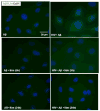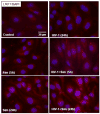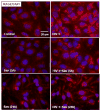HIV-1-induced amyloid beta accumulation in brain endothelial cells is attenuated by simvastatin
- PMID: 19944163
- PMCID: PMC2818553
- DOI: 10.1016/j.mcn.2009.11.004
HIV-1-induced amyloid beta accumulation in brain endothelial cells is attenuated by simvastatin
Abstract
HIV-1-infected brains are characterized by increased amyloid deposition. To study the influence of HIV-1 on amyloid beta (Abeta) homeostasis at the blood-brain barrier (BBB) level, we employed a model of brain microvascular endothelial cells exposed to HIV-1 in the presence or absence of Abeta. HIV-1 markedly increased endogenous Abeta levels and elevated accumulation of exogenous Abeta. Simvastatin, the HMG-CoA reductase inhibitor, blocked these effects. We next evaluated the effects of HIV-1 and/or simvastatin on expression of the receptor for lipoprotein related protein (LRP1) and the receptor for advanced glycation end products (RAGE), known to regulate Abeta transport across the BBB. LRP1 expression was not affected by HIV-1; however, it was increased by simvastatin. Importantly, simvastatin attenuated HIV-1-induced RAGE expression. These results suggest that HIV-1 may directly contribute to Abeta accumulation at the BBB level. In addition, statins may protect against increased Abeta levels associated with HIV-1 infection in the brain.
Copyright 2009 Elsevier Inc. All rights reserved.
Figures













Similar articles
-
Simvastatin protects against amyloid beta and HIV-1 Tat-induced promoter activities of inflammatory genes in brain endothelial cells.Mol Pharmacol. 2008 May;73(5):1424-33. doi: 10.1124/mol.107.042028. Epub 2008 Feb 14. Mol Pharmacol. 2008. PMID: 18276775 Free PMC article.
-
Effect of High Cholesterol Regulation of LRP1 and RAGE on Aβ Transport Across the Blood-Brain Barrier in Alzheimer's Disease.Curr Alzheimer Res. 2021;18(5):428-442. doi: 10.2174/1567205018666210906092940. Curr Alzheimer Res. 2021. PMID: 34488598
-
Regulatory effects of simvastatin and apoJ on APP processing and amyloid-β clearance in blood-brain barrier endothelial cells.Biochim Biophys Acta Mol Cell Biol Lipids. 2018 Jan;1863(1):40-60. doi: 10.1016/j.bbalip.2017.09.008. Epub 2017 Sep 20. Biochim Biophys Acta Mol Cell Biol Lipids. 2018. PMID: 28941799
-
Clearance of amyloid-beta peptide across the blood-brain barrier: implication for therapies in Alzheimer's disease.CNS Neurol Disord Drug Targets. 2009 Mar;8(1):16-30. doi: 10.2174/187152709787601867. CNS Neurol Disord Drug Targets. 2009. PMID: 19275634 Free PMC article. Review.
-
Role of the blood-brain barrier in the pathogenesis of Alzheimer's disease.Curr Alzheimer Res. 2007 Apr;4(2):191-7. doi: 10.2174/156720507780362245. Curr Alzheimer Res. 2007. PMID: 17430246 Review.
Cited by
-
HIV effects on age-associated neurocognitive dysfunction: premature cognitive aging or neurodegenerative disease?Alzheimers Res Ther. 2015 Apr 6;7(1):37. doi: 10.1186/s13195-015-0123-4. eCollection 2015. Alzheimers Res Ther. 2015. PMID: 25848401 Free PMC article.
-
Intraneuronal β-Amyloid Accumulation: Aging HIV-1 Human and HIV-1 Transgenic Rat Brain.Viruses. 2022 Jun 10;14(6):1268. doi: 10.3390/v14061268. Viruses. 2022. PMID: 35746739 Free PMC article.
-
Endothelial LRP1 regulates metabolic responses by acting as a co-activator of PPARγ.Nat Commun. 2017 Apr 10;8:14960. doi: 10.1038/ncomms14960. Nat Commun. 2017. PMID: 28393867 Free PMC article.
-
Role of Cav-1 in HIV-1 Tat-Induced Dysfunction of Tight Junctions and Aβ-Transferring Proteins.Oxid Med Cell Longev. 2019 May 14;2019:3403206. doi: 10.1155/2019/3403206. eCollection 2019. Oxid Med Cell Longev. 2019. PMID: 31217837 Free PMC article.
-
Low-Density Lipoprotein Receptor-Related Protein-1 Signaling in Angiogenesis.Front Cardiovasc Med. 2017 May 22;4:34. doi: 10.3389/fcvm.2017.00034. eCollection 2017. Front Cardiovasc Med. 2017. PMID: 28589128 Free PMC article. Review.
References
-
- Bhaskaran K, Mussini C, Antinori A, Walker AS, Dorrucci M, Sabin C, Phillips A, Porter K. Changes in the incidence and predictors of human immunodeficiency virus-associated dementia in the era of highly active antiretroviral therapy. Ann Neurol. 2008;63:213–221. - PubMed
-
- Blanc EM, Toborek M, Mark RJ, Hennig B, Mattson MP. Amyloid beta-peptide induces cell monolayer albumin permeability, impairs glucose transport, and induces apoptosis in vascular endothelial cells. J Neurochem. 1997;68:1870–1881. - PubMed
-
- Brew BJ, Crowe SM, Landay A, Cysique LA, Guillemin G. Neurodegeneration and ageing in the HAART era. J Neuroimmune Pharmacol. 2009;4:163–174. - PubMed
Publication types
MeSH terms
Substances
Grants and funding
LinkOut - more resources
Full Text Sources
Medical
Miscellaneous

